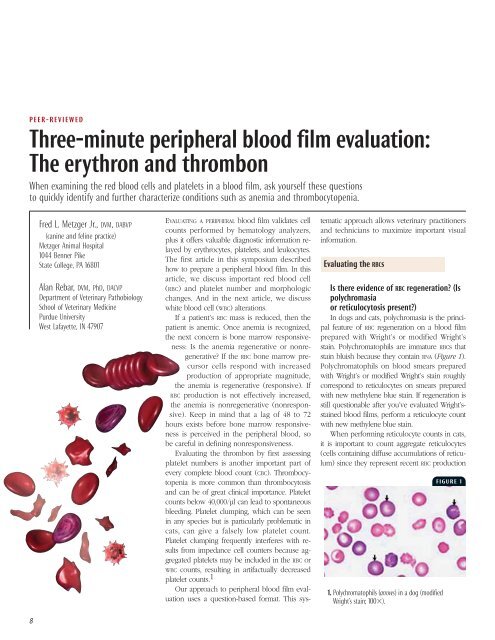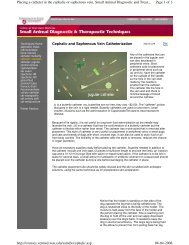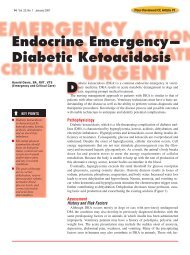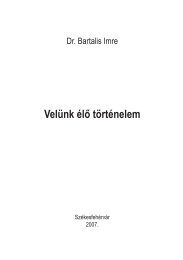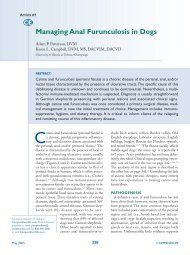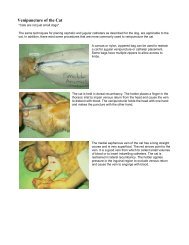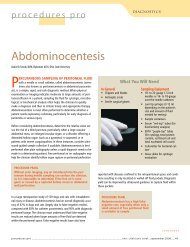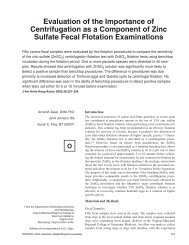evaluating blood films evaluating blood films - Hungarovet
evaluating blood films evaluating blood films - Hungarovet
evaluating blood films evaluating blood films - Hungarovet
- No tags were found...
Create successful ePaper yourself
Turn your PDF publications into a flip-book with our unique Google optimized e-Paper software.
PEER-REVIEWEDThree-minute peripheral <strong>blood</strong> film evaluation:The erythron and thrombonWhen examining the red <strong>blood</strong> cells and platelets in a <strong>blood</strong> film, ask yourself these questionsto quickly identify and further characterize conditions such as anemia and thrombocytopenia.Fred L. Metzger Jr., DVM, DABVP(canine and feline practice)Metzger Animal Hospital1044 Benner PikeState College, PA 16801Alan Rebar, DVM, PhD, DACVPDepartment of Veterinary PathobiologySchool of Veterinary MedicinePurdue UniversityWest Lafayette, IN 47907EVALUATING A PERIPHERAL <strong>blood</strong> film validates cellcounts performed by hematology analyzers,plus it offers valuable diagnostic information relayedby erythrocytes, platelets, and leukocytes.The first article in this symposium describedhow to prepare a peripheral <strong>blood</strong> film. In thisarticle, we discuss important red <strong>blood</strong> cell(RBC) and platelet number and morphologicchanges. And in the next article, we discusswhite <strong>blood</strong> cell (WBC) alterations.If a patient’s RBC mass is reduced, then thepatient is anemic. Once anemia is recognized,the next concern is bone marrow responsiveness:Is the anemia regenerative or nonregenerative?If the RBC bone marrow precursorcells respond with increasedproduction of appropriate magnitude,the anemia is regenerative (responsive). IfRBC production is not effectively increased,the anemia is nonregenerative (nonresponsive).Keep in mind that a lag of 48 to 72hours exists before bone marrow responsivenessis perceived in the peripheral <strong>blood</strong>, sobe careful in defining nonresponsiveness.Evaluating the thrombon by first assessingplatelet numbers is another important part ofevery complete <strong>blood</strong> count (CBC). Thrombocytopeniais more common than thrombocytosisand can be of great clinical importance. Plateletcounts below 40,000/µl can lead to spontaneousbleeding. Platelet clumping, which can be seenin any species but is particularly problematic incats, can give a falsely low platelet count.Platelet clumping frequently interferes with resultsfrom impedance cell counters because aggregatedplatelets may be included in the RBC orWBC counts, resulting in artifactually decreasedplatelet counts. 1Our approach to peripheral <strong>blood</strong> film evaluationuses a question-based format. This systematicapproach allows veterinary practitionersand technicians to maximize important visualinformation.Evaluating the RBCsIs there evidence of RBC regeneration? (Ispolychromasiaor reticulocytosis present?)In dogs and cats, polychromasia is the principalfeature of RBC regeneration on a <strong>blood</strong> filmprepared with Wright’s or modified Wright’sstain. Polychromatophils are immature RBCs thatstain bluish because they contain RNA (Figure 1).Polychromatophils on <strong>blood</strong> smears preparedwith Wright’s or modified Wright’s stain roughlycorrespond to reticulocytes on smears preparedwith new methylene blue stain. If regeneration isstill questionable after you’ve evaluated Wright’sstained<strong>blood</strong> <strong>films</strong>, perform a reticulocyte countwith new methylene blue stain.When performing reticulocyte counts in cats,it is important to count aggregate reticulocytes(cells containing diffuse accumulations of reticulum)since they represent recent RBC production1. Polychromatophils (arrows) in a dog (modifiedWright’s stain; 100).FIGURE 18


